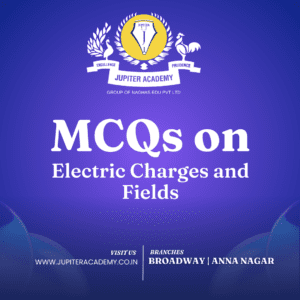NEET 2025: OMR Sheet Filling Tips to Avoid Mistakes Preparing...
Read MoreMCQ'S ON ELECTRIC CHARGES AND FIELDS

Sure! Here are some NEET (National Eligibility cum Entrance Test) multiple-choice questions on Electric Charges and Fields :
1. Which of the following statements about electric charges is true?
a) Like charges attract each other.
b) Unlike charges repel each other.
c) Neutral charges have an excess of electrons.
d) Electric charges exist only in insulators.
2. Two point charges of +4 μC and -2 μC are placed 10 cm apart in vacuum. What is the electric field at a point 5 cm from the +4 μC charge along the line joining the charges?
a) 8 N/C
b) 16 N/C
c) 32 N/C
d) 64 N/C
3. The force between two charges placed in a medium is 27 N. If the medium is replaced with another medium, and the distance between the charges is doubled while keeping the charges the same, what will be the new force?
a) 108 N
b) 54 N
c) 27 N
d) 13.5 N
4. An electric dipole is placed in a uniform electric field. Which of the following statements is true?
a) The dipole experiences a torque but no net force.
b) The dipole experiences a net force but no torque.
c) The dipole experiences both a torque and a net force.
d) The dipole does not experience any torque or net force.
5. The electric potential due to a point charge is given by V = kQ/r, where V is the electric potential, k is a constant, Q is the charge, and r is the distance from the charge. What is the SI unit of k?
a) N/C
b) J/C
c) J/C²
d) Nm²/C²
6. Two parallel plates are connected to a battery. If the potential difference between the plates is doubled, what happens to the electric field between them?
a) It becomes half.
b) It doubles.
c) It remains the same.
d) It becomes zero.
7. An electron is placed in an electric field. In which direction does the electric force on the electron act?
a) In the direction of the electric field.
b) Opposite to the direction of the electric field.
c) Perpendicular to the direction of the electric field.
d) The direction depends on the charge of the electron.
8. The electric field inside a conductor in electrostatic equilibrium is:
a) Zero.
b) Maximum.
c) Minimum.
d) Variable.
9. Two charges, +q and -2q, are placed at a distance ‘d’ apart. At what point on the line joining the charges is the electric field zero?
a) At the midpoint of the line.
b) At a point closer to the -2q charge.
c) At a point closer to the +q charge.
d) The electric field is never zero on the line.
10. The net electric field inside a hollow charged conducting sphere is:
a) Zero.
b) Maximum at the center.
c) Maximum at the surface.
d) Minimum at the surface.
Answers:
1. b) Unlike charges repel each other.
2. a) 8 N/C
3. c) 27 N
4. a) The dipole experiences a torque but no net force.
5. c) J/C²
6. c) It remains the same.
7. a) In the direction of the electric field.
8. a) Zero.
9. a) At the midpoint of the line.
10. a) Zero.
Certainly! Here are a few JEE Main MCQs on Electric Charges and Fields along with their answers:
1. Two point charges +Q and -Q are placed at a distance of ‘d’ apart in vacuum. What is the electric field at the midpoint between them?
(a) Zero
(b) Q/(2πε₀d²) in the direction from -Q to +Q
(c) Q/(4πε₀d²) in the direction from -Q to +Q
(d) Q/(8πε₀d²) in the direction from -Q to +Q
Answer: (a) Zero
2. Two positive point charges of magnitude +Q are placed on the x-axis at distances ‘a’ and ‘3a’ from the origin, respectively. What is the electric field at the point (2a, 0)?
(a) Zero
(b) 2kQ/a² in the positive x-direction
(c) 2kQ/a² in the negative x-direction
(d) 4kQ/a² in the positive x-direction
Answer: (b) 2kQ/a² in the positive x-direction
3. Three equal point charges +Q, +Q, and -Q are placed at the vertices of an equilateral triangle. What is the electric field at the centroid of the triangle?
(a) Zero
(b) kQ/3a² in the direction opposite to the -Q charge
(c) kQ/3a² in the direction of the -Q charge
(d) kQ/9a² in the direction opposite to the -Q charge
Answer: (a) Zero
4. A positive charge +Q is placed inside a spherical cavity within a neutral conductor. What is the electric field inside the cavity?
(a) Zero
(b) kQ/r² directed towards the center of the cavity
(c) kQ/r² directed away from the center of the cavity
(d) kQ/r directed towards the center of the cavity
Answer: (a) Zero
5. A uniformly charged rod of length L has a total charge Q. What is the electric field at a point P on the perpendicular bisector of the rod at a distance d from the center of the rod?
(a) kQd/(2L² + d²) in the direction towards the rod
(b) kQd/(L² + d²) in the direction towards the rod
(c) kQd/(L² + d²) in the direction away from the rod
(d) kQd/(2L² + d²) in the direction away from the rod
Answer: (a) kQd/(2L² + d²) in the direction towards the rod
These are just a few examples of JEE Main MCQs on Electric Charges and Fields. I hope you find them helpful!
TN Medical 2024 Counseling: Extension of Round 2 for MBBS & BDS
TN Medical 2024 Counseling: Extension of Round 2 for MBBS...
Read MoreTENTATIVE ROUND-II COUNSELLING SCHEDULE FOR ADMISSION TO MBBS/BDS
Registration Starts from 11-09-2024 10:00 A.M to 13-09-2024 05:00 P.M....
Read MoreMCQ’S ON ELECTRIC CHARGES AND FIELDS MCQ’S ON ELECTRIC CHARGES AND FIELDS MCQ’S ON ELECTRIC CHARGES AND FIELDS MCQ’S ON ELECTRIC CHARGES AND FIELDS MCQ’S ON ELECTRIC CHARGES AND FIELDS MCQ’S ON ELECTRIC CHARGES AND FIELDS MCQ’S ON ELECTRIC CHARGES AND FIELDS MCQ’S ON ELECTRIC CHARGES AND FIELDS MCQ’S ON ELECTRIC CHARGES AND FIELDS
MCQ’S ON ELECTRIC CHARGES AND FIELDS MCQ’S ON ELECTRIC CHARGES AND FIELDS MCQ’S ON ELECTRIC CHARGES AND FIELDS MCQ’S ON ELECTRIC CHARGES AND FIELDS MCQ’S ON ELECTRIC CHARGES AND FIELDS MCQ’S ON ELECTRIC CHARGES AND FIELDS MCQ’S ON ELECTRIC CHARGES AND FIELDS MCQ’S ON ELECTRIC CHARGES AND FIELDS MCQ’S ON ELECTRIC CHARGES AND FIELDS






